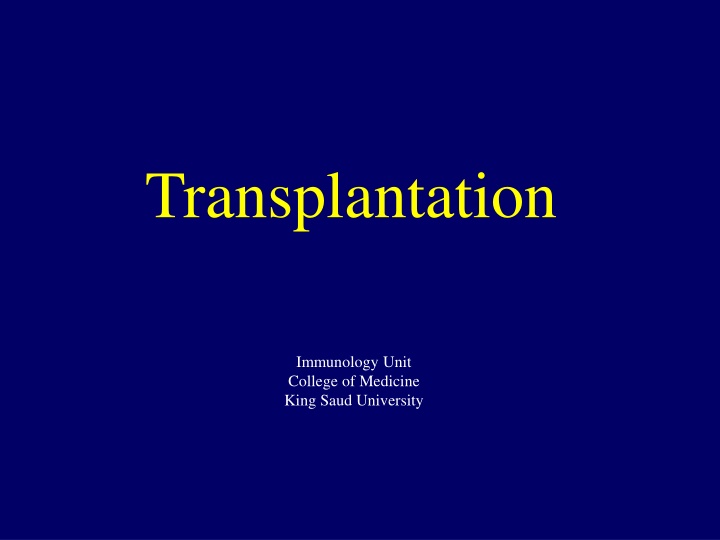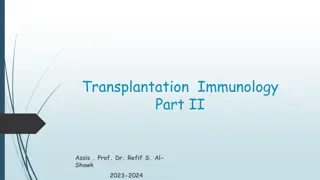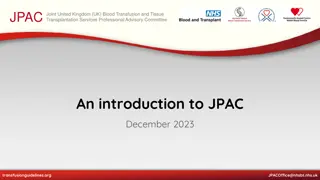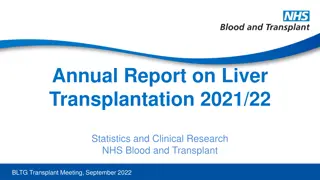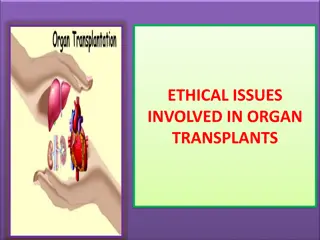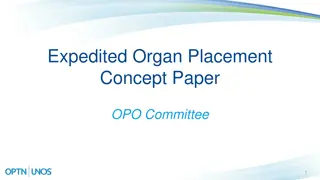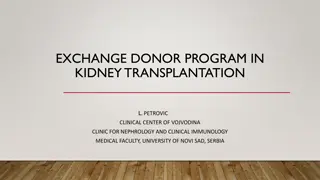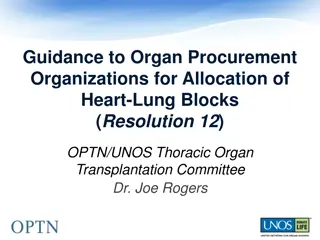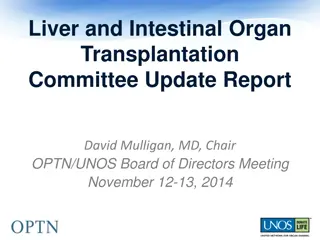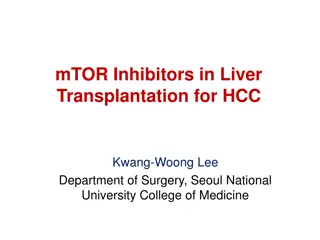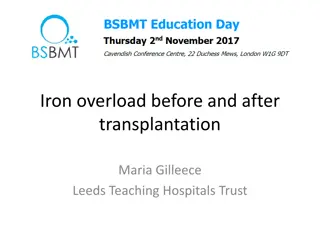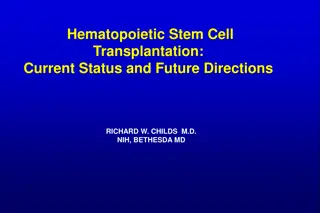Overview of Major Histocompatibility Complex in Organ Transplantation
Major Histocompatibility Complex (MHC) plays a crucial role in organ transplantation success. Understanding HLA antigens, MHC Class I and II proteins, and gene clusters on chromosome 6 is essential for managing post-transplantation outcomes and immune responses. Each individual's unique haplotypes contribute to tissue matching and transplant compatibility.
Uploaded on Mar 03, 2025 | 0 Views
Download Presentation

Please find below an Image/Link to download the presentation.
The content on the website is provided AS IS for your information and personal use only. It may not be sold, licensed, or shared on other websites without obtaining consent from the author.If you encounter any issues during the download, it is possible that the publisher has removed the file from their server.
You are allowed to download the files provided on this website for personal or commercial use, subject to the condition that they are used lawfully. All files are the property of their respective owners.
The content on the website is provided AS IS for your information and personal use only. It may not be sold, licensed, or shared on other websites without obtaining consent from the author.
E N D
Presentation Transcript
Transplantation Immunology Unit College of Medicine King Saud University
Objectives To understand the diversity among human leukocyte antigens (HLA) or major histo- compatibility complex (MHC) To know the role of HLA antigens in transplant rejection and graft versus host disease To be familiar with types of immune responses mediating transplant rejections and graft versus host disease and importance of tissue matching To understand the principles of management after transplantation
Major Histocompatibility Complex and Transplantation Major histocompatibility complex (MHC) proteins were discovered for the first time with the advent of tissue transplantation The success of tissue and organ transplantation depends upon the donor s and recipient s human leukocyte antigens (HLA) encoded by HLA genes These proteins are allo-antigens
MHC Class I and II Proteins MHC Class I are glycoproteins found on surface of virtually all the nucleated cells Cytotoxic T cell kills virus infected cells in association with class I MHC proteins MHC Class II glycoproteins are normally found on the surface of antigen presenting cells (marophages, B cells, and dendritic cells) Helper T cell recognize antigen in association with class II MHC proteins
Major Histocompatibility Complex and Transplantation Genes for HLA proteins are clustered in the MHC complex located on the short arm of chromosome 6 Three genes HLA-A, HLA-B and HLA-C code for Class I MHC proteins HLA-D loci encode for Class II MHC proteins ie, DP, DQ and DR
Major Histocompatibility Complex and Transplantation Each individual has two haplotypes i.e, two sets of these genes one paternal and one maternal MHC class I II III Region A B C DP DQ DR C4, C2, BF TNF- TNF- Gene products C' HLA-A HLA-B HLA-C DP DQ DR proteins More than 300 More than 300 HLA HLA- -D D 47 47 88 88 29 29 Polymorphisms
Transplantation Types of transplants: Autografts, Autologous grafts Donor and recipient are same individual Common in skin grafting; bone marrow Syngeneic grafts or (isograft) Donor and recipient are genetically identical Animal models; identical twins
Transplantation Types of transplants: Allogeneic grafts Donor and recipient are same species, but genetically unrelated Common heart, lung, kidney, liver graft Xenogeneic grafts Donor and recipient are different species Artificial grafts
Transplantation (Rejection) Major Barrier to transplantation is the immune response T cells play primary role B cells can/do play a role Classic adaptive/acquired immune response Memory Specificity
Transplantation T cells play primary role in 1st and 2nd set rejection reactions Nude mice accept allografts (no T cells due to genetic modification resulting in absent thymus) B cell deficient mice reject allografts Nude mouse has a transplant of rabbit skin
Role of CD4+ versus CD8 T+ cells Injecting recipient mice with monoclonal antibodies to deplete one or both types of T cells
Mechanisms involved in Graft Rejection Direct Pathway Indirect Pathway
Clinical manifestations of graft rejection Hyperacute rejection: very quick I. II. Acute rejection: about 10 days (cell mediated) III. Chronic rejection: months-years (both)
Chronic Rejection This occurs months to years after engraftment Main pathologic finding in chronic rejection is atherosclerosis of the vascular endothelium Main cause of chronic rejection is not known Minor histo-compatibility antigen miss match
Minor antigens and Transplantation Minor antigens unknown They mount a weak immune response Play role in chronic rejection of a graft There are no laboratory tests to detect minor antigens
Graft-versus-Host (GVH) Reaction Occurs in about two thirds of bone marrow transplants Occurs because grafted immunocompetent T cells proliferate in the irradiated immunocompromised host and reject cells with foreign proteins resulting in sever organ dysfunction Donor s Tc cells play a major role in destroying the recipient s cells Symptoms are: maculopapular rash, jaundice, hepatosplenomegaly and diarrhea GVH reactions usually end in infections and death
HLA Typing in the Laboratory Prior to transplantation laboratory test commonly called as HLA typing or tissue typing to determine the closest MHC match between the donor and recipient is performed Methods DNA sequencing by Polymerase Chain Reaction (PCR) Serologic Assays Mixed Lymphocyte Reaction (MLR) Crossmatching (Donor) lymphocytes +(Recipient) serum + complement.
Tissue Matching Effect of HLA class I & II matching on survival of kidney grafts
General Immunosuppression Therapy 1) Mitotic inhibitor: azathioprine (pre & post) 2) Corticosteroids 3) Cyclosporin 4) Total lymphoid irradiation
Specific Immuno-suppression therapy a) Monoclonal antibodies against T cell components or cytokines b) Agents blocking co-stimulatory signal
Immuno-suppresive Therapy Downsides Must be maintained for life Toxicity Susceptibility to infections Susceptibility to tumors
Take home messages HLA or MHC molecule miss-match can stimulate humoral and cell mediated immunity which is the main cause of rejection of transplants Cell mediated immune responses play a major role in transplant rejection Tissue matching particularly for HLA-D antigens is important for successful transplantation Immuno-suppresive therapy is usually required after transplantation
